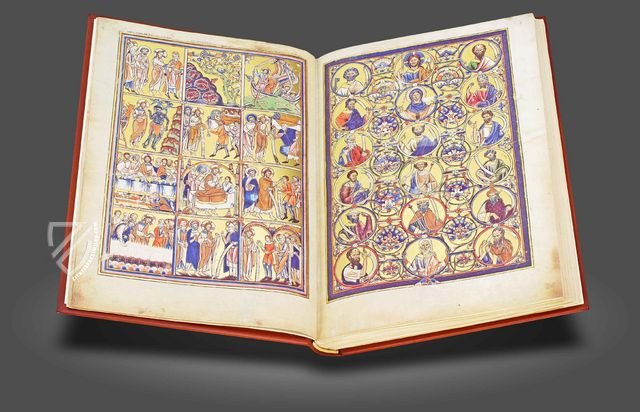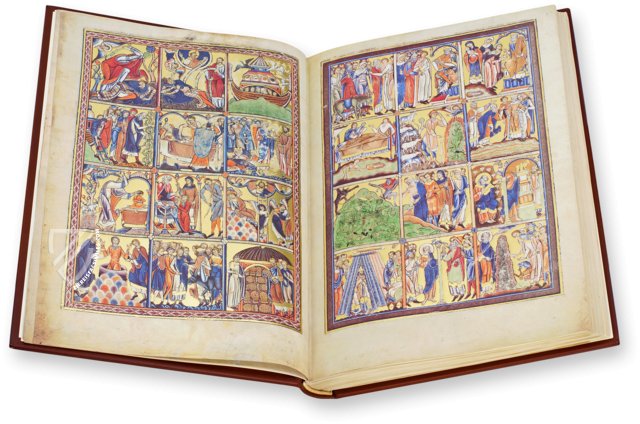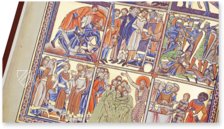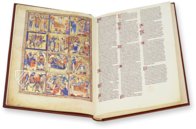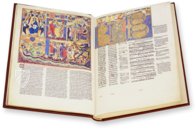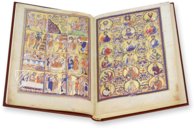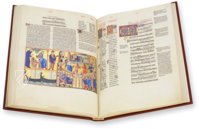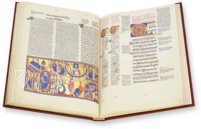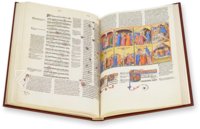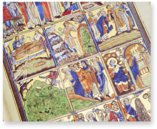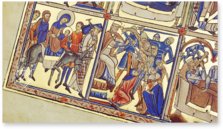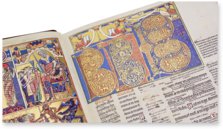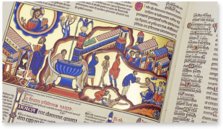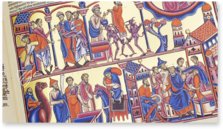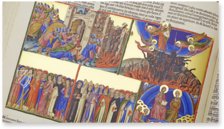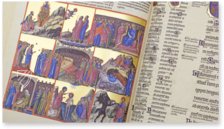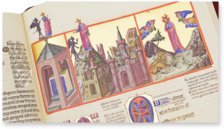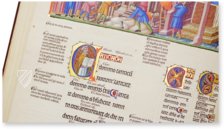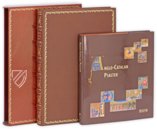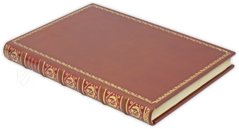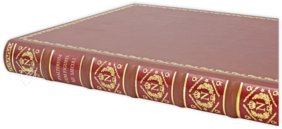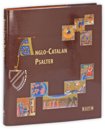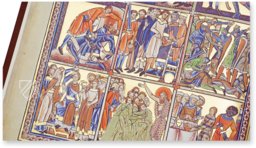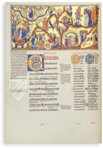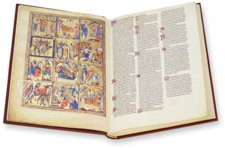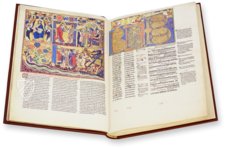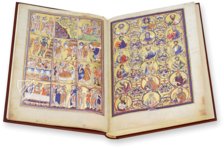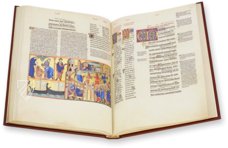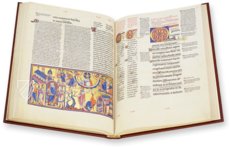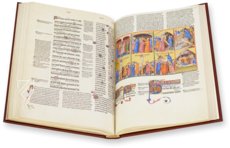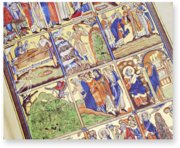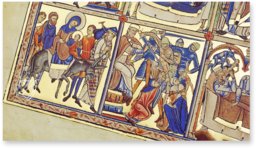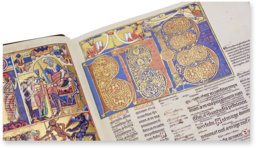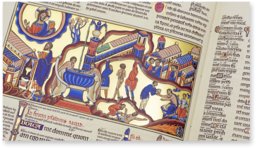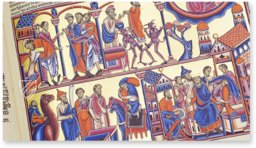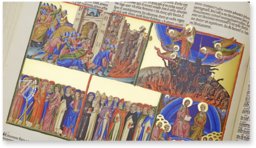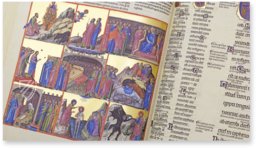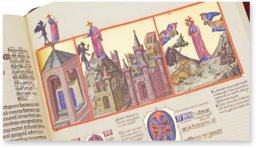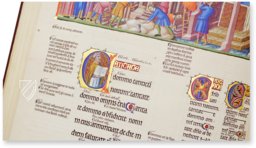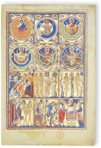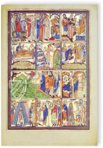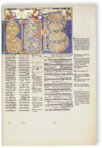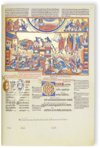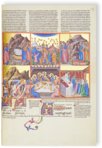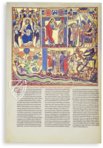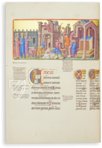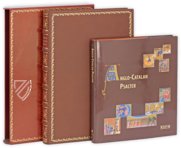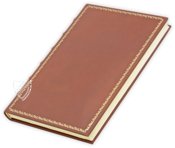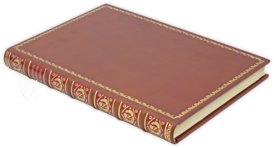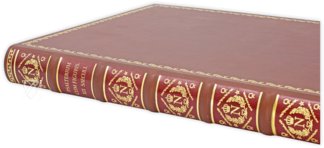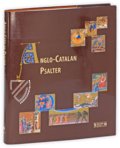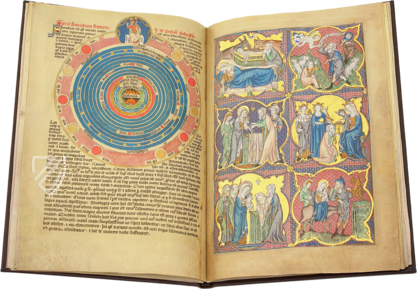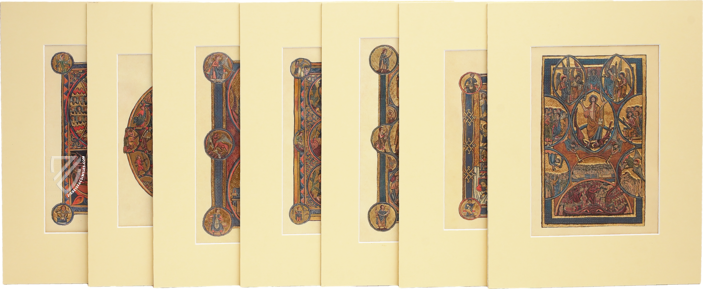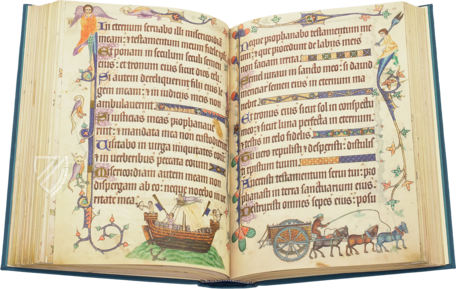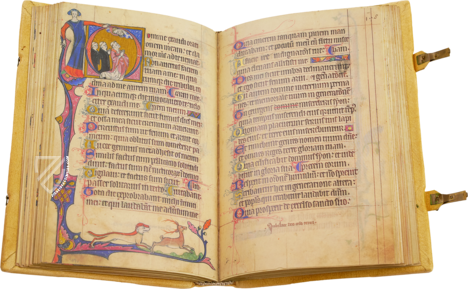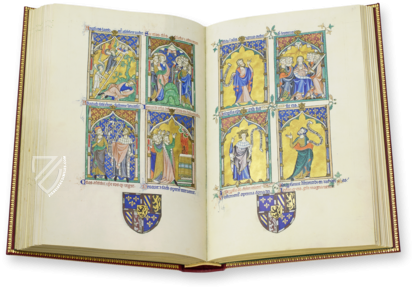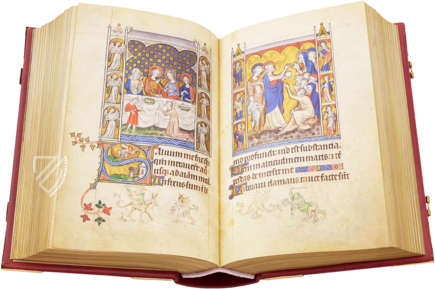Great Canterbury Psalter
(3,000€ - 7,000€)
The Great Canterbury Psalter consists of two different parts. The first part of the manuscript was created ca. 1200 in Canterbury, England, the second part ca. 1350 in Catalonia, Spain. The different styles make the manuscript a unique work of art in the world. It contains 140 high quality and interesting miniatures with precious colors and gold worked in different ways. These miniatures represent high-quality examples of the Romanesque and Gothic styles and the highly coveted manuscript has passed through the hands of various aristocrats of the first rank.
Great Canterbury Psalter
In the French National Library there is a psalter which is exceptional in every way, in which two works from different epochs are combined in one grandiose codex. The Great Canterbury Psalter, which contains the three Latin versions of the Psalms attributed to St. Jerome, was partly produced in England and partly in Spain. The exciting work of art contains over 140 miniatures by first class book masters, who depict the prevailing conceptual world of their time in pictures. Numerous decorative initials and gold embellishments additionally decorate the text.
Various Stylistic Directions
The fascinating Great Canterbury Psalter is a work that consists of two parts, which were produced at completely different times. The first part arose in English Canterbury ca. 1200. The second part was produced around 150 years later in Catalonia. This temporal difference between both parts is clearly discernable in the illustrations of the work. The English originates from a time in which Late Romanesque painting was being gradually supplanted by the painting of the world of Gothic. The full-page miniatures and charming initials show influences from the masterworks of Late Gothic book art. The Catalonian part of the manuscript is oriented on 14th century Italian painting. Both parts of the books are of excellent quality and reflect new artistic ideas alongside classical traditions.
The Adventurous History of the Psalter
Medieval psalters were concerned with collections of the Psalms, which are attributed to King David. They usually served purposes of private study. The special Great Canterbury Psalter was nevertheless a work, for which its owners enjoyed astonishment and admiration. The owners came from the highest ranks of each epoch and are to be sought among the most influential rulers. Soon after its production, the incomplete manuscript went from England to Spain and came into the possession of Duke Jean de Valois. It was later purchased by Princess Margarete of Austria. This she left to her niece, Queen Mary of Hungary. In 1809, it received a new binding in Paris in the reign of Napoleon I. The manuscript is still found in Paris today.
Noteworthy Book Art
The miniatures of the psalter are shaped in a special manner after each Psalm. The pictures are always divided into several scenes and show a variety of high quality colors. Most are laid against a carmine red background and are adorned with filigreed and polished gold leaf. The second part of the manuscript was demonstrably illustrated by the studio of Ferrer and Arnau Bassas, two of the great Spanish book painters of the Middle Ages. The stylistic influences from various epochs and lands make the illuminated manuscript a unique work of art worldwide.
Codicology
- Alternative Titles
- Salterio Glosado
Salterio Anglo-Catalán
Anglo-Katalanischer Psalter
Der Große Canterbury Psalter
Salterio Glossato
Psautier Anglo-Catalan
Saltério Glosado
Anglo Catalan Psalter - Size / Format
- 356 pages / 48.0 × 32.2 cm
- Origin
- Spain
- Date
- Ca. 1200 and ca. 1350
- Style
- Genre
- Language
- Script
- English Vernacular minuscule
- Illustrations
- More than 140 fascinating miniatures including 8 full pages embellished with gold, 28 historiated initials, and 190 ornamental letters upon gold ground with plants motifs
- Patron
- The second part was completed at the behest of King Peter IV of Aragon (1319–87) "The Ceremonious"
- Artist / School
- Ferrer Bassa (ca. 1285–1348)
- Previous Owners
- Jean, Duke of Berry (1340–1416)
Charles Croy
Margaret of Austria (1480–1530)
Mary of Hungary (1505–58)
Archduke Albert I of Belgium (1875–1934)
Great Canterbury Psalter
The Last Supper
In the center miniature we see the Last Supper with the Twelve Apostles assembled neatly around the table. Christ is pictured holding the Eucharist and giving the sign of benediction, he is flanked by a depiction of Communion on the right and the Ark of the Covenant on the left being carried by the Israelites. “And He took bread, gave thanks and broke it, and gave it to them, saying, ‘This is My body which is given for you; do this in remembrance of Me’.” (Luke 22:19)
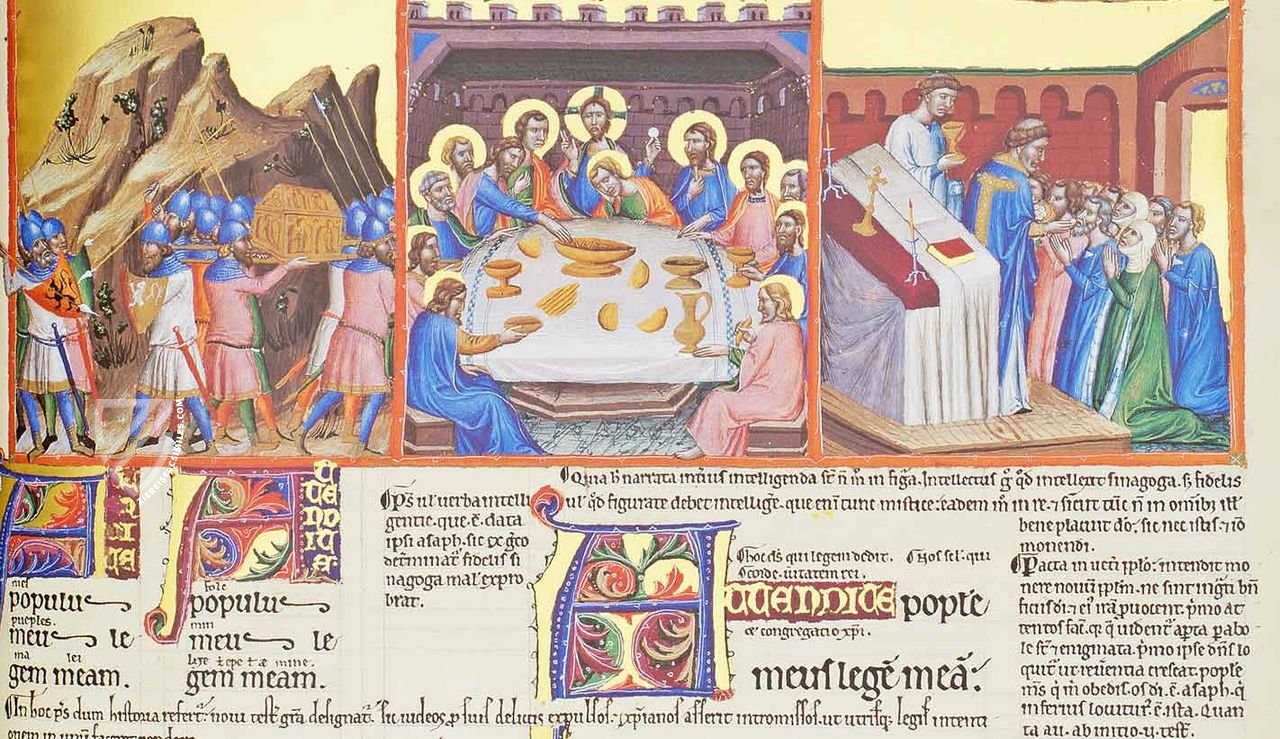
Great Canterbury Psalter
Scenes from Genesis
At the beginning of the manuscript, the events from the beginning of Genesis are portrayed in a full-page miniature broken up into 12 scenes. They are neatly arranged within a frame of red, blue, and gold leaf. The first six depict the stages of Creation, from God holding a compass and scales in the void to Adam surrounded by all the animals he must now name.
The second half of these scenes depict events of the Garden of Eden and the fall of man, resulting in their expulsion. A now-clothed Adam and Eve are now next in the world outside Paradise with Adam toiling while Eve is afflicted by the challenges of child rearing. Their infant sons, Cain and Abel, are depicted as grown men in the last scene, making their offerings to God.
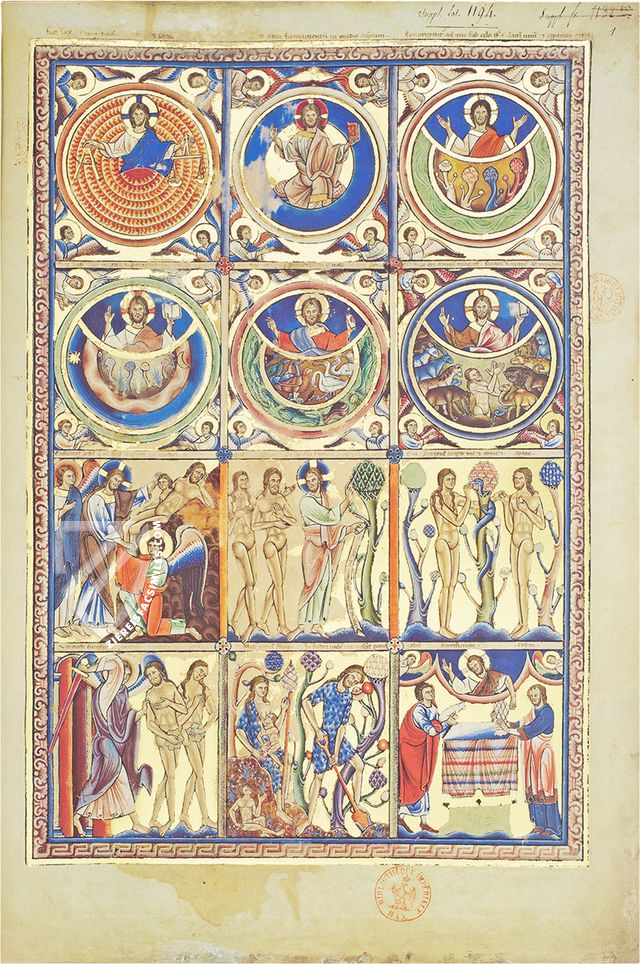
#1 Salterio Glosado
Language: Spanish
(3,000€ - 7,000€)
- Treatises / Secular Books
- Apocalypses / Beatus
- Astronomy / Astrology
- Bestiaries
- Bibles / Gospels
- Chronicles / History / Law
- Geography / Maps
- Saints' Lives
- Islam / Oriental
- Judaism / Hebrew
- Single Leaf Collections
- Leonardo da Vinci
- Literature / Poetry
- Liturgical Manuscripts
- Medicine / Botany / Alchemy
- Music
- Mythology / Prophecies
- Psalters
- Other Religious Books
- Games / Hunting
- Private Devotion Books
- Other Genres
- Afghanistan
- Armenia
- Austria
- Belgium
- Belize
- Bosnia and Herzegovina
- China
- Colombia
- Costa Rica
- Croatia
- Cyprus
- Czech Republic
- Denmark
- Egypt
- El Salvador
- Ethiopia
- France
- Germany
- Greece
- Guatemala
- Honduras
- Hungary
- India
- Iran
- Iraq
- Israel
- Italy
- Japan
- Jordan
- Kazakhstan
- Kyrgyzstan
- Lebanon
- Liechtenstein
- Luxembourg
- Mexico
- Morocco
- Netherlands
- Palestine
- Panama
- Peru
- Poland
- Portugal
- Romania
- Russia
- Serbia
- Spain
- Sri Lanka
- Sweden
- Switzerland
- Syria
- Tajikistan
- Turkey
- Turkmenistan
- Ukraine
- United Kingdom
- United States
- Uzbekistan
- Vatican City
- A. Oosthoek, van Holkema & Warendorf
- Aboca Museum
- Ajuntament de Valencia
- Akademie Verlag
- Akademische Druck- u. Verlagsanstalt (ADEVA)
- Aldo Ausilio Editore - Bottega d’Erasmo
- Alecto Historical Editions
- Alkuin Verlag
- Almqvist & Wiksell
- Amilcare Pizzi
- Andreas & Andreas Verlagsbuchhandlung
- Archa 90
- Archiv Verlag
- Archivi Edizioni
- Arnold Verlag
- ARS
- Ars Magna
- ArtCodex
- AyN Ediciones
- Azimuth Editions
- Badenia Verlag
- Bärenreiter-Verlag
- Belser Verlag
- Belser Verlag / WK Wertkontor
- Benziger Verlag
- Bernardinum Wydawnictwo
- BiblioGemma
- Biblioteca Apostolica Vaticana (Vaticanstadt, Vaticanstadt)
- Bibliotheca Palatina Faksimile Verlag
- Bibliotheca Rara
- Boydell & Brewer
- Bramante Edizioni
- Bredius Genootschap
- Brepols Publishers
- British Library
- C. Weckesser
- Caixa Catalunya
- Canesi
- CAPSA, Ars Scriptoria
- Caratzas Brothers, Publishers
- Carus Verlag
- Casamassima Libri
- Centrum Cartographie Verlag GmbH
- Chavane Verlag
- Christian Brandstätter Verlag
- Circulo Cientifico
- Club Bibliófilo Versol
- Club du Livre
- CM Editores
- Collegium Graphicum
- Collezione Apocrifa Da Vinci
- Comissão Nacional para as Comemorações dos Descobrimentos Portugueses
- Coron Verlag
- Corvina
- CTHS
- D. S. Brewer
- Damon
- De Agostini/UTET
- De Nederlandsche Boekhandel
- De Schutter
- Deuschle & Stemmle
- Deutscher Verlag für Kunstwissenschaft
- DIAMM
- Droz
- E. Schreiber Graphische Kunstanstalten
- Ediciones Boreal
- Ediciones Grial
- Ediclube
- Edições Inapa
- Edilan
- Editalia
- Edition Deuschle
- Edition Georg Popp
- Edition Leipzig
- Edition Libri Illustri
- Editiones Reales Sitios S. L.
- Éditions de l'Oiseau Lyre
- Editions Medicina Rara
- Editorial Casariego
- Editorial Mintzoa
- Editrice Antenore
- Editrice Velar
- Edizioni Edison
- Egeria, S.L.
- Eikon Editores
- Electa
- Emery Walker Limited
- Enciclopèdia Catalana
- Eos-Verlag
- Ephesus Publishing
- Ernst Battenberg
- Eugrammia Press
- Extraordinary Editions
- Fackelverlag
- Facsimila Art & Edition
- Facsimile Editions Ltd.
- Facsimilia Art & Edition Ebert KG
- Faksimile Verlag
- Feuermann Verlag
- Folger Shakespeare Library
- Franco Cosimo Panini Editore
- Friedrich Wittig Verlag
- Fundación Hullera Vasco-Leonesa
- G. Braziller
- Gabriele Mazzotta Editore
- Gebr. Mann Verlag
- Gesellschaft für graphische Industrie
- Getty Research Institute
- Giovanni Domenico de Rossi
- Giunti Editore
- Graffiti
- Grafica European Center of Fine Arts
- Guido Pressler
- Guillermo Blazquez
- Gustav Kiepenheuer
- H. N. Abrams
- Harrassowitz
- Harvard University Press
- Helikon
- Hendrickson Publishers
- Henning Oppermann
- Herder Verlag
- Hes & De Graaf Publishers
- Hoepli
- Holbein-Verlag
- Houghton Library
- Hugo Schmidt Verlag
- Idion Verlag
- Il Bulino, edizioni d'arte
- ILte
- Imago
- Insel Verlag
- Insel-Verlag Anton Kippenberger
- Instituto de Estudios Altoaragoneses
- Instituto Nacional de Antropología e Historia
- Introligatornia Budnik Jerzy
- Istituto dell'Enciclopedia Italiana - Treccani
- Istituto Ellenico di Studi Bizantini e Postbizantini
- Istituto Geografico De Agostini
- Istituto Poligrafico e Zecca dello Stato
- Italarte Art Establishments
- Jan Thorbecke Verlag
- Johnson Reprint Corporation
- Josef Stocker
- Josef Stocker-Schmid
- Jugoslavija
- Karl W. Hiersemann
- Kasper Straube
- Kaydeda Ediciones
- Kindler Verlag / Coron Verlag
- Kodansha International Ltd.
- Konrad Kölbl Verlag
- Kurt Wolff Verlag
- La Liberia dello Stato
- La Linea Editrice
- La Meta Editore
- Lambert Schneider
- Landeskreditbank Baden-Württemberg
- Leo S. Olschki
- Les Incunables
- Liber Artis
- Library of Congress
- Libreria Musicale Italiana
- Lichtdruck
- Lito Immagine Editore
- Lumen Artis
- Lund Humphries
- M. Moleiro Editor
- Maison des Sciences de l'homme et de la société de Poitiers
- Manuscriptum
- Martinus Nijhoff
- Maruzen-Yushodo Co. Ltd.
- MASA
- Massada Publishers
- McGraw-Hill
- Metropolitan Museum of Art
- Militos
- Millennium Liber
- Müller & Schindler
- Nahar - Stavit
- Nahar and Steimatzky
- National Library of Wales
- Neri Pozza
- Nova Charta
- Oceanum Verlag
- Odeon
- Orbis Mediaevalis
- Orbis Pictus
- Österreichische Staatsdruckerei
- Oxford University Press
- Pageant Books
- Parzellers Buchverlag
- Patrimonio Ediciones
- Pattloch Verlag
- PIAF
- Pieper Verlag
- Plon-Nourrit et cie
- Poligrafiche Bolis
- Presses Universitaires de Strasbourg
- Prestel Verlag
- Princeton University Press
- Prisma Verlag
- Priuli & Verlucca, editori
- Pro Sport Verlag
- Propyläen Verlag
- Pytheas Books
- Quaternio Verlag Luzern
- Reales Sitios
- Recht-Verlag
- Reichert Verlag
- Reichsdruckerei
- Reprint Verlag
- Riehn & Reusch
- Roberto Vattori Editore
- Rosenkilde and Bagger
- Roxburghe Club
- Salerno Editrice
- Saltellus Press
- Sandoz
- Sarajevo Svjetlost
- Schöck ArtPrint Kft.
- Schulsinger Brothers
- Scolar Press
- Scrinium
- Scripta Maneant
- Scriptorium
- Shazar
- Siloé, arte y bibliofilia
- SISMEL - Edizioni del Galluzzo
- Sociedad Mexicana de Antropología
- Société des Bibliophiles & Iconophiles de Belgique
- Soncin Publishing
- Sorli Ediciones
- Stainer and Bell
- Studer
- Styria Verlag
- Sumptibus Pragopress
- Szegedi Tudomànyegyetem
- Taberna Libraria
- Tarshish Books
- Taschen
- Tempus Libri
- Testimonio Compañía Editorial
- Thames and Hudson
- The Clear Vue Publishing Partnership Limited
- The Facsimile Codex
- The Folio Society
- The Marquess of Normanby
- The Richard III and Yorkist History Trust
- Tip.Le.Co
- TouchArt
- TREC Publishing House
- TRI Publishing Co.
- Trident Editore
- Tuliba Collection
- Typis Regiae Officinae Polygraphicae
- Union Verlag Berlin
- Universidad de Granada
- University of California Press
- University of Chicago Press
- Urs Graf
- Vallecchi
- Van Wijnen
- VCH, Acta Humaniora
- VDI Verlag
- VEB Deutscher Verlag für Musik
- Verlag Anton Pustet / Andreas Verlag
- Verlag Bibliophile Drucke Josef Stocker
- Verlag der Münchner Drucke
- Verlag für Regionalgeschichte
- Verlag Styria
- Vicent Garcia Editores
- W. Turnowski Ltd.
- W. Turnowsky
- Waanders Printers
- Wiener Mechitharisten-Congregation (Wien, Österreich)
- Wissenschaftliche Buchgesellschaft
- Wissenschaftliche Verlagsgesellschaft
- Wydawnictwo Dolnoslaskie
- Xuntanza Editorial
- Zakład Narodowy
- Zollikofer AG

